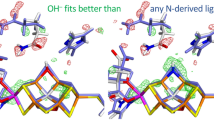Abstract
The X-ray structures of the chloroperoxidase from Curvularia inaequalis, heterologously expressed in Saccharomyces cerevisiae, have been determined both in its apo and in its holo forms at 1.66 and 2.11 Å resolution, respectively. The crystal structures reveal that the overall structure of this enzyme remains nearly unaltered, particularly at the metal binding site. At the active site of the apo-chloroperoxidase structure a clearly defined sulfate ion was found, partially stabilised through electrostatic interactions and hydrogen bonds with positively charged residues involved in the interactions with the vanadate in the native protein. The vanadate binding pocket seems to form a very rigid frame stabilising oxyanion binding. The rigidity of this active site matrix is the result of a large number of hydrogen bonding interactions involving side chains and the main chain of residues lining the active site. The structures of single site mutants to alanine of the catalytic residue His404 and the vanadium protein ligand His496 have also been analysed. Additionally we determined the structural effects of mutations to alanine of residue Arg360, directly involved in the compensation of the negative charge of the vanadate group, and of residue Asp292 involved in forming a salt bridge with Arg490 which also interacts with the vanadate. The enzymatic chlorinating activity is drastically reduced to approximately 1% in mutants D292A, H404A and H496A. The structures of the mutants confirm the view of the active site of this chloroperoxidase as a rigid matrix providing an oxyanion binding site. No large changes are observed at the active site for any of the analysed mutants. The empty space left by replacement of large side chains by alanines is usually occupied by a new solvent molecule which partially replaces the hydrogen bonding interactions to the vanadate. The new solvent molecules additionally replace part of the interactions the mutated side chains were making to other residues lining the active site frame. When this is not possible, another side chain in the proximity of the mutated residue moves in order to satisfy the hydrogen bonding potential of the residues located at the active site frame.
Similar content being viewed by others
Author information
Authors and Affiliations
Additional information
Received: 12 October 1998 / Accepted: 25 January 1999
Rights and permissions
About this article
Cite this article
Macedo-Ribeiro, S., Hemrika, W., Renirie, R. et al. X-ray crystal structures of active site mutants of the vanadium-containing chloroperoxidase from the fungus Curvularia inaequalis . JBIC 4, 209–219 (1999). https://doi.org/10.1007/s007750050306
Issue Date:
DOI: https://doi.org/10.1007/s007750050306




